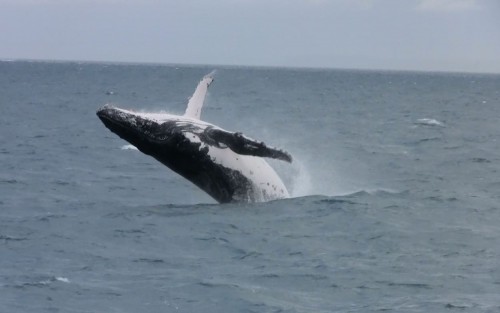Quicksilver Group News
June 27th, 2013The Humpback Whales have Arrived
Silversonic passengers were delighted to spot some of the first humpbacks of the season today off Port Douglas.
The 2 adult humpbacks, were about 14 metres in length and were spotted about 200 metres from the vessel and are believed to be the first humpback sightings of the year.
The whales were playing between Turtle Bay and Castle Rock at Agincourt 2 Reef.
Silversonic skipper Shane Down said “We were travelling between dive sights at about 1.00pm and they were playing, jumping a few times and then they lay on the surface and looked like they went to sleep. It is always exciting to see the humpbacks arrive and a positive for all our passengers and crew. Our guests are just in awe, everyone was on the decks and just delighted to see such an amazing sight”.
With the onset of autumn, humpback whales begin their long trek up the east coast of Australia. They are easily identified by their extremely long pectoral fins and scalloped flukes. Humpbacks are referred to as Baleen whales, as they filter sea water through large fibrous plates in their mouths to feed on the krill. They rarely travel any further north than Cape Tribulation, so we are at the end of their long migration, and they tend to gather here in large numbers.
The reason they travel north is to get to warmer waters to breed and calve. Warm tropical waters have little food for the whales to feast upon, so the whales rely on their fat reserves they have accrued by feeding on krill in Antarctic waters. As they travel up the coast, the whales begin to form small groups or mating pairs.
To actually see one underway is simply the most unbelievable experience you’ll ever have, says Russell Hore, Manager of Quicksilver’s Group Reef Biosearch division.
The whales are regularly sighted at the reef during July to September.
Silversonic passengers were delighted to spot some of the first humpbacks of the season today off Port Douglas. The 2 adult humpbacks, were about 14 metres in length and were spotted about 200 metres from the vessel and are believed to be the first humpback sightings of the year.
The whales were playing between Turtle Bay and Castle Rock at Agincourt 2 Reef.
Silversonic skipper Shane Down said “We were travelling between dive sights at about 1.00pm and they were playing, jumping a few times and then they lay on the surface and looked like they went to sleep. It is always exciting to see the humpbacks arrive and a positive for all our passengers and crew. Our guests are just in awe, everyone was on the decks and just delighted to see such an amazing sight”.
With the onset of autumn, humpback whales begin their long trek up the east coast of Australia. They are easily identified by their extremely long pectoral fins and scalloped flukes. Humpbacks are referred to as Baleen whales, as they filter sea water through large fibrous plates in their mouths to feed on the krill. They rarely travel any further north than Cape Tribulation, so we are at the end of their long migration, and they tend to gather here in large numbers.
The reason they travel north is to get to warmer waters to breed and calve. Warm tropical waters have little food for the whales to feast upon, so the whales rely on their fat reserves they have accrued by feeding on krill in Antarctic waters. As they travel up the coast, the whales begin to form small groups or mating pairs.
To actually see one underway is simply the most unbelievable experience you’ll ever have, says Russell Hore, Manager of Quicksilver’s Group Reef Biosearch division.
The whales are regularly sighted at the reef during July to September.
